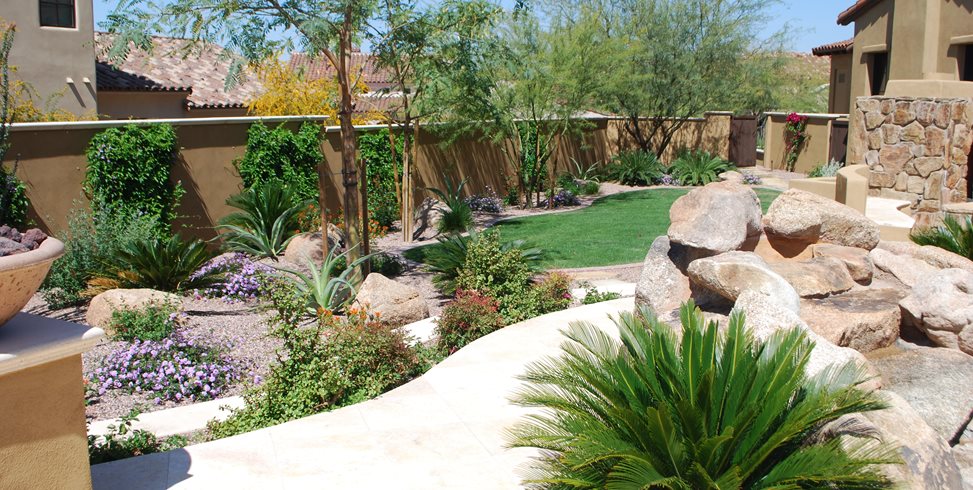Creating a Lush Landscape in the Arizona Desert
There are many options beyond the ubiquitous cactus plant when creating a beautiful desert landscape, as showcased in this project completed by landscape designer Pascale Sucato of Pascale Land Design, Phoenix. The Mediterranean-style home in Arizona’s Sonoran Desert is owned by an older couple who use it primarily as a vacation destination during the fall through spring. It is located in a large, gated community managed by a home owner's association that imposes strict landscaping guidelines specifying the use of plants with low water requirements. Although the home is located in a hot, dry desert climate, the owners do not care much for cacti, requiring some creative plant choices.
Project Challenges
“The challenges of landscaping in the Southwest desert are adequate irrigation, proper sun exposure, and soil amendments. Irrigation is the most significant and can allow plants to flourish where they would otherwise not survive. Even indigenous plants perform better with some irrigation,” says Sucato, whose company specializes in Southwest, Mediterranean, and contemporary landscapes. Exposure to frost was also a concern, since she wanted to use desert plants that would bloom throughout the winter. “We not only have harsh summers, but also freezing winter nights. I did not want plants that would be black from frost when the homeowners arrived,” she says.
Design Solutions
Sucato was hired to design the landscaping at the start of the home's construction, which allowed her to plan all the hardscaping as well, including the driveway, walkways, patios, and fire features. These elements provided the framework for the rest of her design.
Tips for Landscaping a Desert Garden:
- Use plants with low water requirements and variable bloom times for year-round color.
- To enhance the enjoyment of cool desert evenings, install outdoor fire features and low-voltage lights along pathways and within seat walls.
- Provide underground irrigation for potted plants to reduce watering requirements.
- Plant frost-sensitive desert plants close to the house, to minimize exposure and extend their bloom time.
- Use hardscaping as a predominant design element, not only to add structure but also to reduce or eliminate the need for a lawn.
At the front of the property, she created a welcoming entryway by planting Lady Banks climbing rose around the home’s front arches. “They look good all year long and do well down to 10 degrees,” she says. For structure and architectural interest, she also added some Octopus Agaves and Coral Aloes.
The backyard features a patio of honed travertine with darker travertine bordering a free-form pool. Fire bowls on each side of the spa and each side of the seating area add intimacy and nighttime ambience. A water feature made of natural boulders sits between two Sago Palms, which are hardy down to 15 degrees. Fast-growing Tipu trees planted along the back wall provide screening and privacy from an adjacent two-story home.
On the east side of the property, a small water fountain surrounded by a planter with seat walls sits within view of the dining room window. Terraced garden walls enclose the entire area, providing privacy and adding layers of greenery to soften the hardscaping elements. Further into the side yard is a patio adjacent to a large Desert Museum Palo Verde tree, which provides welcome shade from the hot desert sun. The potted plants are irrigated by pipes that run through sleeving installed under the patio. “This is something very important and often forgotten by builders. The irrigation for these pots require a line of their own as the watering schedule needs to be independent of the other lines,” says Sucato.
Pascale Land Design
Phoenix, Ariz.
Get more Arizona landscaping ideas
Learn about travertine pool decks

 Backyards
Backyards
 Front Yards
Front Yards








